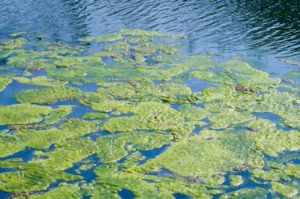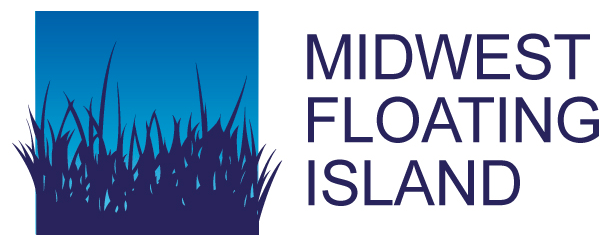During the warm, sunny summer months, lakes and ponds often develop a pale green appearance accompanied by a foul smell. Algae can grow quickly when an excess of nutrients develops in a body of water. Blue-Green algal blooms are dangerous because they create numerous environmental and safety threats.
Preventing the blooms is ideal. First, minimize run off of nutrients into the water by applying less fertilizer and using plants along the shoreline. If the nutrients are already in the water, BioHaven® Floating Islands can reduce the natural disasters cause by algal blooms by competing for nutrients.
What are Blue-Green Algae?
Blue-green algae are actually a type of microbe called cyanobacteria, more commonly known as “pond scum” that almost always exists naturally in bodies of water. Blue-green algae differ from “true algae” in that they are not eaten by other organisms and are thus not an important part of the food chain. Luckily, the population is usually kept low by competition for nutrients essential for growth (phosphorus and nitrogen) with other water-dwelling microscopic organsims. However, when there is an abundance of nutrients and sunlight, a vital ingredient in photosynthesis, blue-green algae populations can increase exponentially, eventually overcrowding the water.
Why are Algal Blooms Bad?
Aside from being aesthetically unappealing, blue-green algal blooms can have a variety of negative effects on aquatic ecosystems. Algae typically grow towards the surface of the water in order to receive more sunlight. During a bloom, the algae populations form floating mats that can become so dense that they block sunlight from reaching underwater plants and plankton, which are both oxygenators of the water and a source of food for larger organisms. This lack of sunlight cripples their ability to photosynthesize and, consequently, the water’s oxygen level rapidly depletes. When this happens, the water is unable to support several species, resulting in a dead zone – a region that is uninhabitable to most plant and animal life.
In addition, blue-green algae can produce chemicals that are toxic in large quantities to humans and pets alike. These toxins, which are usually released into the surrounding water when algal cells are damaged or destroyed, can cause symptoms as minor as rashes to as serious as organ damage. Since it is very difficult to know when they are actually producing these toxins, algal blooms are always a safety concern, especially in areas near aquifers where the potential hazard of ground-water contamination poses a threat to humans. In 2014, 500,000 people in Ohio and Michigan could not drink their tap water for a period due to algal blooms in Lake Erie.
Keeping Blue-Green Algae from Blooming
The root cause of these algal blooms is an excess concentration of nutrients in the water. As previously mentioned, the chemicals required for blue-green algae growth are mainly phosphorous and nitrogen, which are most commonly found in organic fertilizers and animal waste. When it rains, these chemicals “run-off” into nearby bodies of water and serve as fuel for growing algae populations. Therefore, the only sure-fire way to prevent blue-green algae from blooming is to ensure that concentrations of these compounds are kept low.
Floating Treatment Wetlands Reduce Nutrients to Prevent Algal Bloom
This is where BioHaven® Floating Islands, also called Floating Treatment Wetlands, come in. The island combat algae without chemicals. Rather than using potentially harmful chemicals to kill existing algal blooms, which could result in the contamination of the water from toxins being released from the dead algal cells, floating islands prevent algal blooms by reducint the nutrients that cause blue-green algae growth. If implemented along shorelines of lakes, ponds and streams, nutrient-rich run-off will be absorbed by the islands’ plants and the biofilm contained within the matrix material from which floating islands are constructed before they can adversely affect aquatic ecosystems. And since there are no chemicals used in the phytoremediation process that removes these nutrients, there is no risk of further contamination of the water. No excess nutrients means no algal blooms, and no algal blooms means no anoxic conditions that cause dead zones. This is why BioHaven® Floating Islands clean water nature’s way.
For more information, contact
Midwest Floating Island
MidwestFloatingIsland.com| info@MidwestFloatingIsland.com |651-379-2480


5 Comments on “Combat Algae without Chemicals”
Why don’t you suggest to the House of Representatives your technique of clearing out the algae from the Everglades so that it doesn’t harm the ecosystem there. The ghost orchid would never survive it it’s perishing as it is it only grows in the Everglades we need to come up with a way to save it not harm it. Your way is the best for ecosystem.
How deep does the pond need to be to use a floating island?
The pond should be a few feet deep to keep the roots of the plants from growing into the bed of the water. The pond must be wet year-round.
We recommend the pond be at least 3 feet deep because the roots from the native plants will hang down 2-3 feet below the floating island. We prefer these roots do not “root in” and remain hanging to maximize the effectiveness of the islands.
We bought a waterfront property last year and in July we started having algae and by mid August it looked like a golf course green. Is there anything we can do to get rid of this algae?